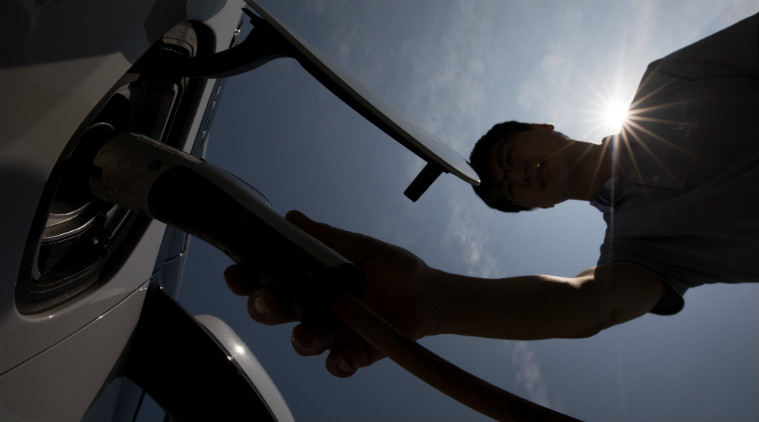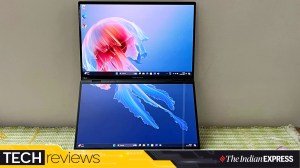- India
- International
Volte-face on Electric Vehicle Policy: Carmakers force the government’s hand
The fact that most manufacturers at this year’s auto expo only showcased concepts on their EV displays, and a growing sense that not much progress has been made on the charging infra front may have caused the govt to backtrack on its plan.
 Carmakers have been asked to leap-frog from the current BS IV emission norms to BS VI norms by 2020. (Illustration: C R Sasikumar)
Carmakers have been asked to leap-frog from the current BS IV emission norms to BS VI norms by 2020. (Illustration: C R Sasikumar)
Among the factors that seem to have played a part in forcing the government to uncharacteristically backtrack on its plan to bring in an Electric Vehicle (EV) Policy, two seem apparent. One, a perceptibly tepid response by big auto firms at this year’s expo, where barring two homegrown firms, Tata Motors and Mahindra and Mahindra, virtually all of the big global firms restricted their EV displays to concepts and rendered the showpiece biennial event — billed as South Asia’s biggest auto show — pretty much a non-event this time round. Most automakers were of the view that they were completely invested in the transition to the BS-VI auto fuel norms at this point in time and that they would prefer to wait for more clarity from the government before firming up their EV plans. Carmakers have been asked to leap-frog from the current BS IV emission norms to BS VI norms by 2020.
The second factor appears to be the growing sense within the sector that the government was not doing enough on getting the charging infrastructure in place, a crucial prerequisite for its high-decibel target of going all-electric by 2030. The EV Policy was supposed to be a comprehensive roadmap for the transition, including an indication of a preference of EV technology – a provision that had manufacturers worried as they felt that choice of technology should be left to them, as was the case in countries such as Norway and Denmark.
Besides, the legal and regulatory framework for setting up the charging infrastructure is making slow progress, with jury still out on the question of whether EV charging should be treated as a ‘service business’ or as purely the ‘sale of electricity’. The Centre is learnt to have set up a committee chaired by the Member Planning, Central Electricity Authority (CEA) — the apex policy advisory body in the power sector — to recommend the way forward for developing EV charging infrastructure in India to catalyse the introduction of EVs on a large scale. The progress is excruciatingly slow, though, given that there’s just 12 years to go for the 2030 deadline.
The volte-face was evident on February 16, when Nitin Gadkari, Minister for Road Transport, declared at a press briefing: “There is no need for any policy now.” He was addressing reporters along with Amitabh Kant, chief executive of the government’s policy think tank Niti Aayog. “What we need is just action plans,” added Kant, backing Gadkari’s stand on the policy. Every day, new technology is coming into the market. Technology is always ahead of rules and regulations. And in India, it becomes very tough to change rules and regulations, so let there be just actions,” Kant said, explaining the rationale behind the decision.
 the manufacturers claim that a hybrid vehicle base also spawns the manufacture of the battery ecosystem, which can then be leveraged for a BEV push. (Image Source: Bloomberg)
the manufacturers claim that a hybrid vehicle base also spawns the manufacture of the battery ecosystem, which can then be leveraged for a BEV push. (Image Source: Bloomberg)
Carmakers are visibly elated, with the climbdown by the government. A senior executive with one of India’s biggest car firms said that with the policy being dropped, companies will now have the leeway to choose a technology they want.

In the run-up to this decision, car makers had been making a strong pitch for a technology-agnostic approach to the all-electric goal. Globally, the electric vehicle or EV definition covers a broad range — Battery Electric Vehicles (BEVs), convention Hybrid Electric Vehicles, Plug-in Hybrid Electric Vehicles and Fuel Cell Vehicles. Car makers such as domestic market leader Maruti Suzuki India and Toyota Kirloskar Motors had asserted that the government should define emission norms that EVs need to adhere to even as the choice of technology should be left to the manufacturers and consumers.
“I think that the goal should be that India needs to go from a particular CO2 (carbon dioxide) level to a new CO2 level and then one can decide what to do. Should one go for alternate fuel, hybrid, electric… That choice should be given to the customer and to the manufacturer. The technology should not be determined,” CV Raman, executive director – Engineering, Maruti Suzuki India had told The Indian Express prior to the Government’s decision to backtrack on the proposed policy.
While there are several steps towards reaching the goal of full electrification, the component ecosystem is very similar in all of these and the hybrid technology is a good intermediate step towards achieving an all-electric goal, he said. Hybrids typically have improved fuel efficiency through electrification of powertrain even as they do not require the setting up of charging infrastructure base that is an essential for BEVs. Additionally, the manufacturers claim that a hybrid vehicle base also spawns the manufacture of the battery ecosystem, which can then be leveraged for a BEV push.
Shekar Viswanathan, vice-chairman, Toyota Kirloskar Motors said that his company had specifically told the government that “it doesn’t matter which technology comes in, it should be seen if it is delivering the energy options in clean and efficient manner”. “The government must recognise is that electric vehicles are easier to make and are simpler than IC (internal combustion) engines… If you have more hybrids, then battery sourcing becomes an advantage and cost of battery may come down. So chances of even electric vehicles becoming more affordable will critically depend on whether hybrid vehicles are encouraged,” Viswanathan said. Carmakers such as Toyota have been lobbying with the government to get taxes on hybrid cars lowered.
Globally, EVs are bracketed under four broad categories:
* Conventional hybrid electric vehicles or HEVs such as the Toyota Camry sold in the country combine a conventional internal combustion engine system with an electric propulsion system, resulting in a hybrid vehicle drivetrain that substantially lowers fuel usage. The onboard battery in a conventional hybrid is charged when the IC engine is powering the drivetrain.
* Plug-in hybrid vehicles or PHEVs, such as the Chevrolet Volt, too have a hybrid drivetrain that use both an internal combustion engine and electric power for motive power, backed by rechargeable batteries that, in this case, can be plugged into a power source.
* BEV such as the Nissan Leaf or Tesla Model S, which have no internal combustion engine or fuel tank, run on a fully electric drivetrain powered by rechargeable batteries.
* Fuel cell vehicles or FCVs such as Toyota’s Mirai and Honda’s Clarity use hydrogen gas to power an on-board electric motor. FCVs combine hydrogen and oxygen to produce electricity, which runs the motor, while the only residue of the chemical process being water. Since they’re powered entirely by electricity, FCVs are considered EVs but unlike BEVs, their range and refueling processes are comparable to conventional cars and trucks.
In India, however, the definition of EV only covers BEVs, where the government has lowered the taxes to 12 per cent. At 43 per cent, hybrid electric vehicle attract the same tax applicable on IC vehicles. Manufacturers such as Toyota Kirloslar are lobbying hard for a reduction of the tax on hybrids to 28 per cent.
‘Monetary sops not enough for EV push’
India could save 64% of energy demand for road transport and 37% of carbon emissions by 2030 by pursuing a shared, electric and connected mobility future, as per a NITI Aayog report. Many countries have attempted to push e-mobility through multiple initiatives, generating a push through stringent regulations and lucrative tax incentives, however, monetary incentives alone cannot drive EV penetration, according to McKinsey & Co data. For example, while West Virginia in the US offers the most monetary incentives for EVs, it has seen low EV adoption. California, on the other hand, offers fewer monetary incentives, but has the highest penetration, thanks to the government’s investment in providing robust EV infrastructure, parking benefits and workplace charging facilities.
More Tech
Apr 16: Latest News
- 01
- 02
- 03
- 04
- 05







































